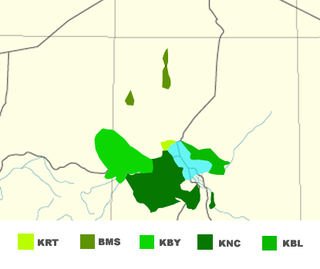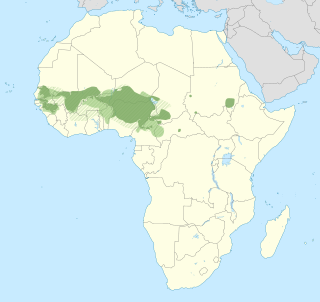
Kanuri is a Saharan dialect continuum of the Nilo–Saharan language family spoken by the Kanuri and Kanembu peoples in Nigeria, Niger, Chad and Cameroon, as well as by a diaspora community residing in Sudan.
The Tumbuka language is a Bantu language which is spoken in Malawi, Zambia, and Tanzania. It is also known by the autonym Chitumbuka also spelled Citumbuka — the chi- prefix in front of Tumbuka means "in the manner of", and is understood in this case to mean "the language of the Tumbuka people". Tumbuka belongs to the same language group as Chewa and Sena.
Berta proper, a.k.a. Gebeto, is spoken by the Berta in Sudan and Ethiopia. As of 2006 Berta had approximately 180,000 speakers in Sudan.

Fula, also known as Fulani or Fulah, is a Senegambian language spoken by around 36.8 million people as a set of various dialects in a continuum that stretches across some 18 countries in West and Central Africa. Along with other related languages such as Serer and Wolof, it belongs to the Atlantic geographic group within Niger–Congo, and more specifically to the Senegambian branch. Unlike most Niger-Congo languages, Fula does not have tones.

Rajasthani languages are a group of Indo-Aryan languages and dialects spoken primarily in the state of Rajasthan and adjacent areas of Haryana, Gujarat and Madhya Pradesh in India. There are also speakers in the Pakistani provinces of Punjab and Sindh. Rajasthani is also spoken to a lesser extent in Nepal where it is spoken by 25,394 people according to the 2011 Census of Nepal.
Tukang Besi is an Austronesian language spoken in the Tukangbesi Islands in southeast Sulawesi in Indonesia by a quarter million speakers. A Tukang Besi pidgin is used in the area.
Tonga (Chitonga), also known as Zambezi, is a Bantu language primarily spoken by the Tonga people who live mainly in the Southern province, Lusaka province, Central Province and Western province of Zambia, and in northern Zimbabwe, with a few in northwest Mozambique. The language is also spoken by the Iwe, Toka and Leya people among others, as well as many bilingual Zambians and Zimbabweans. In Zambia Tonga is taught in schools as first language in the whole of Southern Province, Lusaka and Central Provinces.

The Tati language is a Northwestern Iranian language spoken by the Tat people of Iran which is closely related to other languages such as Talysh, Mazandarani and Gilaki.
Yao is a Bantu language in Africa with approximately two million speakers in Malawi, and half a million each in Tanzania and Mozambique. There are also some speakers in Zambia. In Malawi, the main dialect is Mangochi, mostly spoken around Lake Malawi. In Mozambique, the main dialects are Makale and Massaninga. The language has also gone by several other names in English, including chiYao or ciYao, Achawa, Adsawa, Adsoa, Ajawa, Ayawa, Ayo, Ayao, Djao, Haiao, Hiao, Hyao, Jao, Veiao, and waJao.
Zaiwa is a Burmish language spoken in parts of southwest China and eastern Burma. There are around 100,000 speakers. It is also known as Atsi, its name in Jingpo. Zaiwa may be spelled 'Tsaiva' or 'Tsaiwa', and Atsi may be spelled 'Aci', 'Aji', 'Atshi', 'Atzi' or 'Azi'. Other names include Atsi-Maru, Szi and Xiaoshanhua. Pela (Bola), with 400 speakers, was once classified as a dialect. From the 1950s Zaiwa was written using the Roman script. A Gospel of Mark was published in Zaiwa in 1938 in the Fraser alphabet and in 1951 in the Roman script.

S’gaw, S'gaw Karen, or S’gaw K’Nyaw, commonly known as Karen, is a Sino-Tibetan language spoken by the S'gaw Karen people of Myanmar and Thailand. A Karenic branch of the Sino-Tibetan language family, S'gaw Karen is spoken by over 2 million people in Tanintharyi Region, Ayeyarwady Region, Yangon Region, and Bago Region in Myanmar, and about 200,000 in northern and western Thailand along the border near Kayin State. It is written using the S'gaw Karen alphabet, derived from the Burmese script, although a Latin-based script is also in use among the S'gaw Karen in northwestern Thailand.
Hehe, also known by its native name Kihehe, is a Bantu language that is spoken by the Hehe people of the Iringa region of Tanzania, lying south of the Great Ruaha River. It was reported to have "Ngoni" features, that is, words of a Zulu-like language introduced when conquered by a Nguni or Zulu-like people in the early 19th century. However, other "Ngoni" speeches seem to have lost most of these distinctive features over the past 150-odd years, the language more resembling those of the neighbouring peoples. In the 1970s, it was estimated that 190,000 people spoke Hehe. There has been some Bible translation. Hehe may be mutually intelligible with Bena.
Bena is a Bantu language spoken by the Bena people of the Iringa region of Tanzania.
Balanta is a group of two closely related Bak languages of West Africa spoken by the Balanta people.
Central Asmat is a Papuan language of West New Guinea, spoken by the Asmat people.
Mundang is an Mbum language of southern Chad and northern Cameroon.
Xokleng or Laklãnõ is a Southern Jê language spoken by the Xokleng people of Brazil. It is closely related to Kaingang.
Machiguenga (Matsigenka) is a major Arawakan language in the Campa sub-branch of the family. It is spoken in the Urubamba River Basin and along the Manu River in the Cusco and Madre de Dios departments of Peru by around 6,200 people. According to Ethnologue, it is experiencing pressure from Spanish and Quechua in the Urubamba region, but is active and healthy in the Manu region. It is close enough to Nomatsiguenga that the two are sometimes considered dialects of a single language; both are spoken by the Machiguenga people. Nanti is partially mutually intelligible but ethnically distinct.
Orokaiva is a Papuan language spoken in the "tail" of Papua New Guinea.
Bunama is an Austronesian language spoken in the D'Entrecasteaux Islands of Papua New Guinea.




